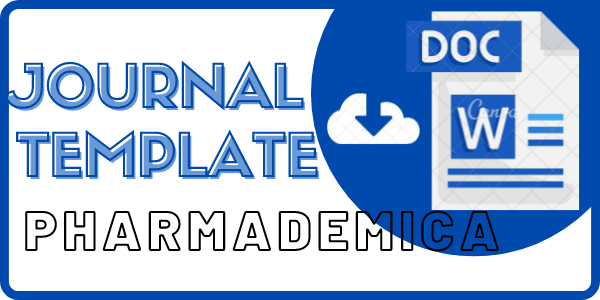Evaluation of The Treatment in Hospitalized Geriatric Stroke Patients at Elizabeth Hospital Situbondo for The Period November 2022-August 2023
DOI:
https://doi.org/10.54445/pharmademica.v5i1.102
 Abstract View:
Abstract View:
182
 PDF downloads:
PDF downloads:
188
Keywords:
Beers Criteria, Elderly, Evaluation, Inappropriate Drugs, StrokeAbstract
Potentially Inappropriate Medicines (PIMs) cause a significant issue, particularly when dealing with elderly patients. Aging in the elderly results in a decline in physiological body functions, impacting the response to medications. Furthermore, aging leads to decreased elasticity of blood vessels, increasing the risk of cardiovascular diseases such as stroke. The management of stroke requires special attention to minimize the risk of complications and enhance recovery opportunities. This study aims to analyze patient profiles, treatment profiles, and evaluate the treatment based on the Beers Criteria 2019. It is a retrospective descriptive study using a cross-sectional research design and purposive sampling technique for sample selection. The study sample includes elderly patients diagnosed with stroke who were hospitalized at RS Elizabeth Situbondo. Patient medical record data was collected through a specifically designed Data Collection Sheet (DCS) to evaluate drug utilization in these patients.
The research findings indicate that the patients are predominantly male (53.2%), aged 60-69 (62.3%), and have a Length of Stay of 1-6 days (84.4%). All patients have payment status through BPJS. The treatment profile involves the administration of medications for stroke management, with ticagrelor as the primary drug (66.2%) and citicoline as the most commonly prescribed supplementary drug (97.4%). Treatment evaluation identified 193 events of drug use that potentially met the 2019 Beers Criteria. The highest category was potentially inappropriate drugs (134 events), with pantoprazole being the most commonly used drug (71 events).
Downloads
References
Abbas, M., Malicke, D. T., & Schramski, J. T. (2025). Stroke Anticoagulation(Archived). Dalam StatPearls. StatPearls Publishing. http://www.ncbi.nlm.nih.gov/books/NBK549826/
Akkawi, M. E., Abd Aziz, H. H., & Fata Nahas, A. R. (2023). The Impact of Potentially Inappropriate Medications and Polypharmacy on 3-Month Hospital Readmission among Older Patients: A Retrospective Cohort Study from Malaysia. Geriatrics (Basel, Switzerland), 8(3), 49. https://doi.org/10.3390/geriatrics8030049
Alvarez-Sabín, J., & Román, G. C. (2013). The role of citicoline in neuroprotection and neurorepair in ischemic stroke. Brain Sciences, 3(3), 1395–1414. https://doi.org/10.3390/brainsci3031395
Andres, T. M., McGrane, T., McEvoy, M. D., & Allen, B. F. S. (2019). Geriatric Pharmacology: An Update. Anesthesiology Clinics, 37(3), 475–492. https://doi.org/10.1016/j.anclin.2019.04.007
Atun, L., Siswati, T., & Kurdanti, W. (t.t.). ASUPAN SUMBER NATRIUM, RASIO KALIUM NATRIUM, AKTIVITAS FISIK, DAN TEKANAN DARAH PASIEN HIPERTENSI. 6(1).
By the 2023 American Geriatrics Society Beers Criteria® Update Expert Panel. (2023). American Geriatrics Society 2023 updated AGS Beers Criteria® for potentially inappropriate medication use in older adults. Journal of the American Geriatrics Society, 71(7), 2052–2081. https://doi.org/10.1111/jgs.18372
Cha, S., & Kim, S.-S. (2021). Comorbidity Patterns of Mood Disorders in Adult Inpatients: Applying Association Rule Mining. Healthcare, 9(9), 1155. https://doi.org/10.3390/healthcare9091155
Cokro, F., & Jokimawidjaja, J. (2022). Effectiveness of Proton Pump Inhibitors as a Gastrointestinal Bleeding Prophylaxis in Intensive Care Unit: Systematic Review and Meta-Analysis. Journal of Urban Health Research, 1(1), Article 1. https://doi.org/10.25170/juhr.v1i1.3714
Davidson, B. L., Verheijen, S., Lensing, A. W. A., Gebel, M., Brighton, T. A., Lyons, R. M., Rehm, J., & Prins, M. H. (2014). Bleeding risk of patients with acute venous thromboembolism taking nonsteroidal anti-inflammatory drugs or aspirin. JAMA Internal Medicine, 174(6), 947–953. https://doi.org/10.1001/jamainternmed.2014.946
Ding, C., Wu, Y., Chen, X., Chen, Y., Wu, Z., Lin, Z., Kang, D., Fang, W., & Chen, F. (2022). Global, regional, and national burden and attributable risk factors of neurological disorders: The Global Burden of Disease study 1990–2019. Frontiers in Public Health, 10. https://doi.org/10.3389/fpubh.2022.952161
Harris, S., Kurniawan, M., Rasyid, A., Mesiano, T., & Hidayat, R. (2018). Cerebral small vessel disease in Indonesia: Lacunar infarction study from Indonesian Stroke Registry 2012–2014. SAGE Open Medicine, 6, 2050312118784312. https://doi.org/10.1177/2050312118784312
Ishrat, T., Soliman, S., Eldahshan, W., Pillai, B., Ergul, A., & Fagan, S. C. (2018). Silencing VEGF-B diminishes the neuroprotective effect of candesartan treatment after experimental focal cerebral ischemia. Neurochemical research, 43(10), 1869–1878. https://doi.org/10.1007/s11064-018-2604-x
J, D., T, S., & V, E. (2020). Pharmacotherapy: A Pathophysiologic Approach, Eleventh Edition. American Journal of Health-System Pharmacy.
Kamarova, M., Baig, S., Patel, H., Monks, K., Wasay, M., Ali, A., Redgrave, J., Majid, A., & Bell, S. M. (2022). Antiplatelet Use in Ischemic Stroke. The Annals of Pharmacotherapy, 56(10), 1159–1173. https://doi.org/10.1177/10600280211073009
Kang, J.-H., Bae, H.-J., Choi, Y.-A., Lee, S. H., & Shin, H. I. (2016). Length of Hospital Stay After Stroke: A Korean Nationwide Study. Annals of Rehabilitation Medicine, 40(4), 675–681. https://doi.org/10.5535/arm.2016.40.4.675
Kemenkes RI. (2016). Peraturan Menteri Kesehatan Republik Indonesia Nomor 25 Tahun 2016 Tentang Rencana Aksi Nasional Kesehatan Lanjut Usia Tahun 2016-2019.
Kuriakose, D., & Xiao, Z. (2020). Pathophysiology and Treatment of Stroke: Present Status and Future Perspectives. International Journal of Molecular Sciences, 21(20), 7609. https://doi.org/10.3390/ijms21207609
Laily, S. R. (2017). Relationship Between Characteristic and Hypertension with Incidence of Ischemic Stroke. Jurnal Berkala Epidemiologi, 5(1), 48–59. https://doi.org/10.20473/jbe.v5i1.2017.48-59
Lin, K.-H., Lin, H.-J., & Yeh, P.-S. (2022). Determinants of Prolonged Length of Hospital Stay in Patients with Severe Acute Ischemic Stroke. Journal of Clinical Medicine, 11(12), 3457. https://doi.org/10.3390/jcm11123457
Luo, Y., Hao, J., Su, Z., Huang, Y., Ye, F., Qiu, Y., Liu, Z., Chen, Y., Sun, R., & Qiu, Y. (2024). Prevalence and Related Factors of Hypokalemia in Patients with Acute Ischemic Stroke. International Journal of General Medicine, Volume 17, 5697–5705. https://doi.org/10.2147/IJGM.S492025
Ma, X., Li, D., Liu, S., Chen, Y., & Zhong, P. (2023). Efficacy and Safety of Ticagrelor versus Aspirin and Clopidogrel for Stroke Prevention in Patients with Vascular Disease: A Systematic Review and Meta-Analysis. European Neurology, 86(4), 229–241. https://doi.org/10.1159/000530504
McFarland, A. J., Anoopkumar-Dukie, S., Arora, D. S., Grant, G. D., McDermott, C. M., Perkins, A. V., & Davey, A. K. (2014). Molecular Mechanisms Underlying the Effects of Statins in the Central Nervous System. International Journal of Molecular Sciences, 15(11), 20607–20637. https://doi.org/10.3390/ijms151120607
Mosenzon, O., Cheng, A. Y., Rabinstein, A. A., & Sacco, S. (2023). Diabetes and Stroke: What Are the Connections? Journal of Stroke, 25(1), 26–38. https://doi.org/10.5853/jos.2022.02306
Murphy, S. J., & Werring, D. J. (2020). Stroke: Causes and clinical features. Medicine (Abingdon, England: UK Ed.), 48(9), 561–566. https://doi.org/10.1016/j.mpmed.2020.06.002
Negara, Y. R., Machlaurin, A., & Rachmawati, E. (2016). Potensi Penggunaan Obat yang Tidak Tepat pada Peresepan Pasien Geriatri Rawat Jalan di RSD dr. Soebandi Jember Berdasarkan Beers Criteria (Potentially Inappropriate Medication Based on Beers Criteria in Geriatric Outpatients of dr. Soebandi District Hosp. Pustaka Kesehatan, 4(1), Article 1.
Othman, A. I., Abdel-Ghaffar, A., & Mahmoud, A. M. (2019). Ketorolac- and warfarin-induced renal toxicity: Ultrastructural and biochemical study. The Journal of Basic and Applied Zoology, 80(1), 36. https://doi.org/10.1186/s41936-019-0106-2
Overgaard, K. (2014). The effects of citicoline on acute ischemic stroke: A review. Journal of Stroke and Cerebrovascular Diseases: The Official Journal of National Stroke Association, 23(7), 1764–1769. https://doi.org/10.1016/j.jstrokecerebrovasdis.2014.01.020
Pan, B., Jin, X., Jun, L., Qiu, S., Zheng, Q., & Pan, M. (2019). The relationship between smoking and stroke: A meta-analysis. Medicine, 98(12), e14872. https://doi.org/10.1097/MD.0000000000014872
Panel, B. the 2019 A. G. S. B. C. U. E. (2019). American Geriatrics Society 2019 Updated AGS Beers Criteria® for Potentially Inappropriate Medication Use in Older Adults. Journal of the American Geriatrics Society, 67(4), 674–694. https://doi.org/10.1111/jgs.15767
Powers, W. J., Rabinstein, A. A., Ackerson, T., Adeoye, O. M., Bambakidis, N. C., Becker, K., Biller, J., Brown, M., Demaerschalk, B. M., Hoh, B., Jauch, E. C., Kidwell, C. S., Leslie-Mazwi, T. M., Ovbiagele, B., Scott, P. A., Sheth, K. N., Southerland, A. M., Summers, D. V., & Tirschwell, D. L. (2019). Guidelines for the Early Management of Patients With Acute Ischemic Stroke: 2019 Update to the 2018 Guidelines for the Early Management of Acute Ischemic Stroke: A Guideline for Healthcare Professionals From the American Heart Association/American Stroke Association. Stroke, 50(12), e344–e418. https://doi.org/10.1161/STR.0000000000000211
Reza, R. A., Amalia, L., Dahlan, N. L., Juli, C., & Goenawan, H. (2023). PATTERN OF ANTICOAGULANT THERAPY IN CARDIOEMBOLIC STROKE. MNJ (Malang Neurology Journal), 9(2), 139–143. https://doi.org/10.21776/ub.mnj.2023.009.02.11
Rumi, A., Tahir, M. T., & Ilham, M. (2023). Identifikasi Potentially Inappropriate Medication (PIM) Melalui Beers Criteria pada Pasien Geriatri Rawat Inap di Ruangan Seroja dan Flamboyan RSUD Undata Provinsi Sulawesi Tengah: Media Publikasi Promosi Kesehatan Indonesia (MPPKI), 6(1), Article 1. https://doi.org/10.56338/mppki.v6i1.2531
Sapra, A., Malik, A., & Bhandari, P. (2025). Vital Sign Assessment. Dalam StatPearls. StatPearls Publishing. http://www.ncbi.nlm.nih.gov/books/NBK553213/
Schultz, W., & McConachie, I. (2015). Vital signs after haemorrhage – Caution is appropriate. Trends in Anaesthesia and Critical Care, 5. https://doi.org/10.1016/j.tacc.2015.04.001
Yasuda, H., Matsuo, Y., Sato, Y., Ozawa, S., Ishigooka, S., Yamashita, M., Yamamoto, H., & Itoh, F. (2015). Treatment and prevention of gastrointestinal bleeding in patients receiving antiplatelet therapy. World Journal of Critical Care Medicine, 4(1), 40–46. https://doi.org/10.5492/wjccm.v4.i1.40
Downloads
Published
How to Cite
Issue
Section
License
Copyright (c) 2025 Ika Norcahyanti, Adelia Firandi, Zainol Ihsan Mauladi, Afifah Machlaurin

This work is licensed under a Creative Commons Attribution-ShareAlike 4.0 International License.









.png)








